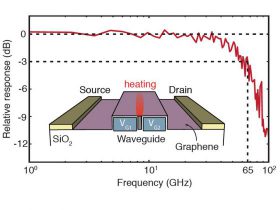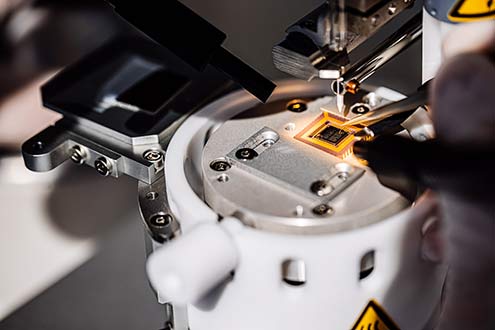New speed record for graphene photodetectors at 65 GHz
 In cooperation with TU Wien researchers from AMO realized the worldwide fastest graphene based photodetector. By demonstrating a -3 dB bandwidth of 65 GHz a new record level could be reached, pushing this technology closer to applications. Graphene, the two-dimensional carbon allotrope, is currently one of the most promising materials for future ultrafast and compact telecommunication systems, as it shows ultimately high carrier mobility, broadband absorption and can be monolithically integrated in silicon photonic systems. In the current work the use of a slot waveguide had a two-fold function, significantly improving the device performance. First, the two separated silicon strips of the slot-waveguide were used as local gate electrodes to increase the detectors sensitivity without reducing the device speed. Second, the light is strongly confined in the slot and is hence absorbed by the graphene exactly in between the p-doped and n-doped regions, maximizing the photoresponse. With this improved response and by minimizing the parasitic capacitance and resistance a record operation speed of 65 GHz was measured, enabling data rates up to 100 GBit/s.
In cooperation with TU Wien researchers from AMO realized the worldwide fastest graphene based photodetector. By demonstrating a -3 dB bandwidth of 65 GHz a new record level could be reached, pushing this technology closer to applications. Graphene, the two-dimensional carbon allotrope, is currently one of the most promising materials for future ultrafast and compact telecommunication systems, as it shows ultimately high carrier mobility, broadband absorption and can be monolithically integrated in silicon photonic systems. In the current work the use of a slot waveguide had a two-fold function, significantly improving the device performance. First, the two separated silicon strips of the slot-waveguide were used as local gate electrodes to increase the detectors sensitivity without reducing the device speed. Second, the light is strongly confined in the slot and is hence absorbed by the graphene exactly in between the p-doped and n-doped regions, maximizing the photoresponse. With this improved response and by minimizing the parasitic capacitance and resistance a record operation speed of 65 GHz was measured, enabling data rates up to 100 GBit/s.
With this step ahead researchers at AMO and TU Wien could not only set a new benchmark for graphene based photodetectors, but also demonstrate that Graphene based photodetectors surpass comparable detectors based on conventional materials concerning maximal operation speeds.
The work was supported by the European Commission through the Flagship project „Graphene“ and the Austrian Science Fund FWF (START Y 539-N16). The publication is published in the international renowned journal Nano Letters.
„Controlled generation of a pn-junction in a waveguide integrated graphene photodetector“
Nano Letters, Just Accepted Manuscript, 10.1021/acs.nanolett.6b03374
http://pubs.acs.org/doi/abs/10.1021/acs.nanolett.6b03374
Graphene Flagship News:
http://graphene-flagship.eu/graphene-photodetectors-set-speed-record





